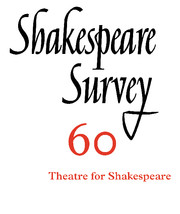Book contents
- Frontmatter
- Professional Players in the Guild Hall, Stratford-upon-Avon, 1568–1597
- Reconstructing The Rose: Development of the Playhouse Building between 1587 and 1592
- The Rose and its Stages
- Philip Henslowe and the Elizabethan Court
- From Revels to Revelation: Shakespeare and the Mask
- Bride-ing the Shrew: Costumes that Matter
- ‘When Men and Women are Alone’: Framing the Taming in India
- The Crown and the Pillow: Royal Properties in Henry IV
- Humanity at Stake: Man and Animal in Shakespeare’s Theatre
- Popular Shakespeare in Japan
- ‘Philosophy in a Gorilla Suit’: Do Shakespearians Perform or Just Perform-a-tive?
- Sudokothellophobia: Writing Hypertextually, Performatively
- Living Monuments: The Spatial Politics of Shakespeare’s Rome on the Contemporary Stage
- ‘In Windsor Forest and at the Boar’s Head’: The ‘Falstaff Plays’ and English Music in the Early Twentieth Century
- Michael Bogdanov in Conversation
- The Mouse and the Urn: Re-Visions of Shakespeare from Voltaire to Ducis
- ‘I covet your skull’: Death and Desire in Hamlet
- Martin Droeshout Redivivus: Reassessing the Folio Engraving of Shakespeare
- Canonizing Shakespeare: The Passionate Pilgrim, England’s Helicon and the Question of Authenticity
- Rereading Shakespeare: The Example of Richard Brathwait
- Shakespeare Performances in England, 2006: January 2006
- Professional Shakespeare Productions in the British Isles January–December 2005
- he Year's Contributions to Shakespearian Study 1 Critical Studies
- 2 Shakespeare in Performance
- 3 Editions and Textual Studies
- Index
2 - Shakespeare in Performance
Published online by Cambridge University Press: 28 November 2007
- Frontmatter
- Professional Players in the Guild Hall, Stratford-upon-Avon, 1568–1597
- Reconstructing The Rose: Development of the Playhouse Building between 1587 and 1592
- The Rose and its Stages
- Philip Henslowe and the Elizabethan Court
- From Revels to Revelation: Shakespeare and the Mask
- Bride-ing the Shrew: Costumes that Matter
- ‘When Men and Women are Alone’: Framing the Taming in India
- The Crown and the Pillow: Royal Properties in Henry IV
- Humanity at Stake: Man and Animal in Shakespeare’s Theatre
- Popular Shakespeare in Japan
- ‘Philosophy in a Gorilla Suit’: Do Shakespearians Perform or Just Perform-a-tive?
- Sudokothellophobia: Writing Hypertextually, Performatively
- Living Monuments: The Spatial Politics of Shakespeare’s Rome on the Contemporary Stage
- ‘In Windsor Forest and at the Boar’s Head’: The ‘Falstaff Plays’ and English Music in the Early Twentieth Century
- Michael Bogdanov in Conversation
- The Mouse and the Urn: Re-Visions of Shakespeare from Voltaire to Ducis
- ‘I covet your skull’: Death and Desire in Hamlet
- Martin Droeshout Redivivus: Reassessing the Folio Engraving of Shakespeare
- Canonizing Shakespeare: The Passionate Pilgrim, England’s Helicon and the Question of Authenticity
- Rereading Shakespeare: The Example of Richard Brathwait
- Shakespeare Performances in England, 2006: January 2006
- Professional Shakespeare Productions in the British Isles January–December 2005
- he Year's Contributions to Shakespearian Study 1 Critical Studies
- 2 Shakespeare in Performance
- 3 Editions and Textual Studies
- Index
Summary
On first reading, the subtitle to Christoph Clausen's comparative study of Verdi's and Shakespeare's Macbeth seems a little unwieldy: 'negotiating historical and medial difference'. Amplified by Clausen's own metaphor of travelling between his two texts as 'two nations', however, it offers three axes for the development of the field of performance criticism evidenced in the books under consideration. Performances in different times and places are usefully triangulated by a notion of performance as the translation of Shakespeare's texts into different media: visual art, film and music as well as theatre.
Stuart Sillars's Painting Shakespeare: The Artist as Critic, 1720–1820 argues that the visual artists he discusses derive their inspiration from reading, rather than seeing, Shakespeare. He begins with John Wootton's 1750 painting Macbeth and Banquo meeting the Weird Sisters. Wootton depicts the two captains in plumed helmets and Jacobite drapes in the bottom centre of a forbidding khaki woodland scene from which three piratical female figures in chimneypot hats emerge, barefoot and leaning on sticks. Two birds are silhouetted against the bright break in the clouds. The composition of the picture bears down heavily on the figures, overwhelming them with the dark tones of windswept vegetation. It is one of sixteen colour plates – not enough – and 101 black and white illustrations to this volume. Sillars expertly sketches the ways in which this illustration draws on naturalistic painting conventions and on Gaspard Dughtet and Poussin, rather than on the theatrical Macbeth reintroduced by Garrick, arguing that its context is textual and art historical rather than dramatic.
- Type
- Chapter
- Information
- Shakespeare Survey , pp. 353 - 360Publisher: Cambridge University PressPrint publication year: 2007



